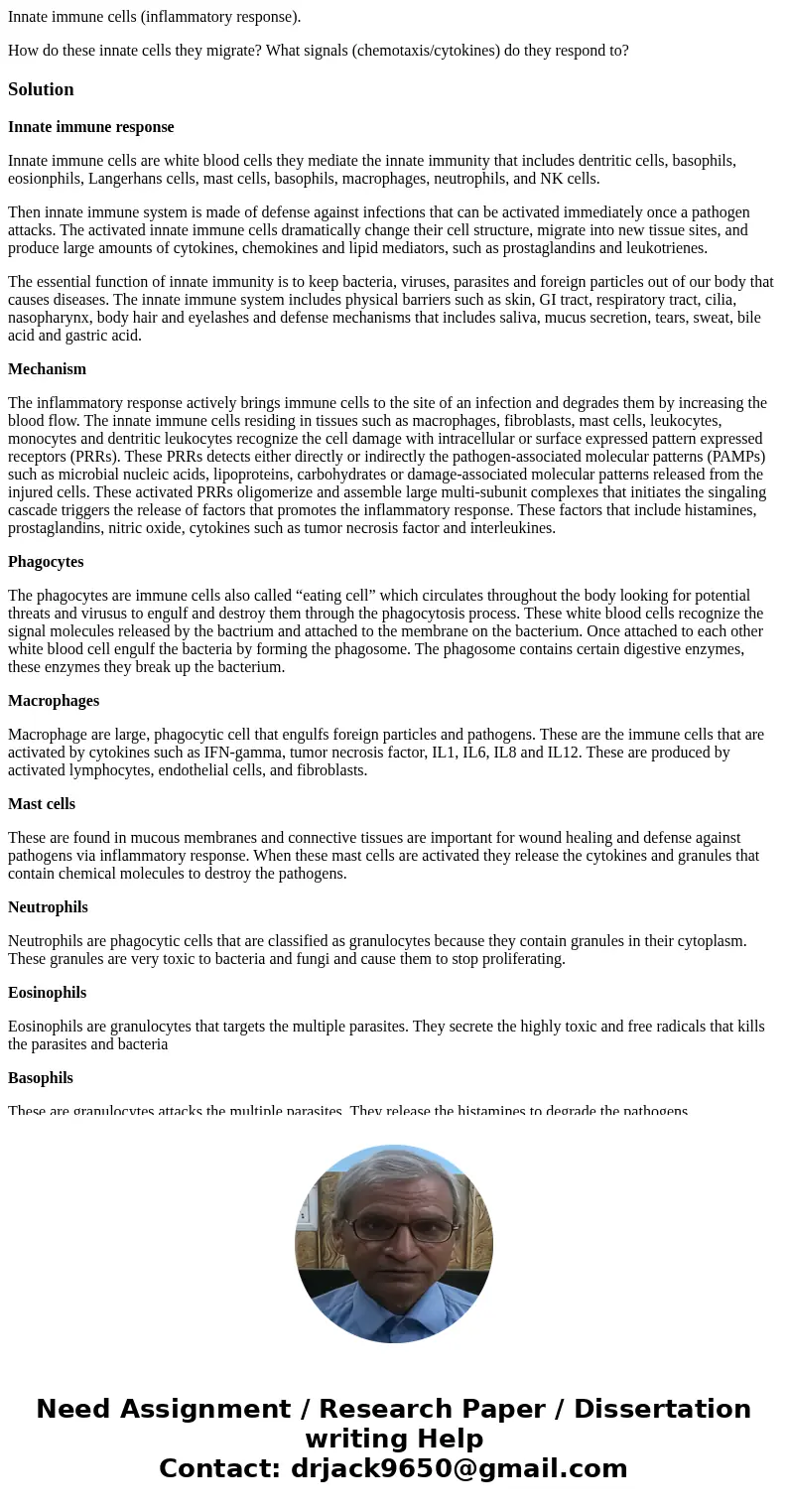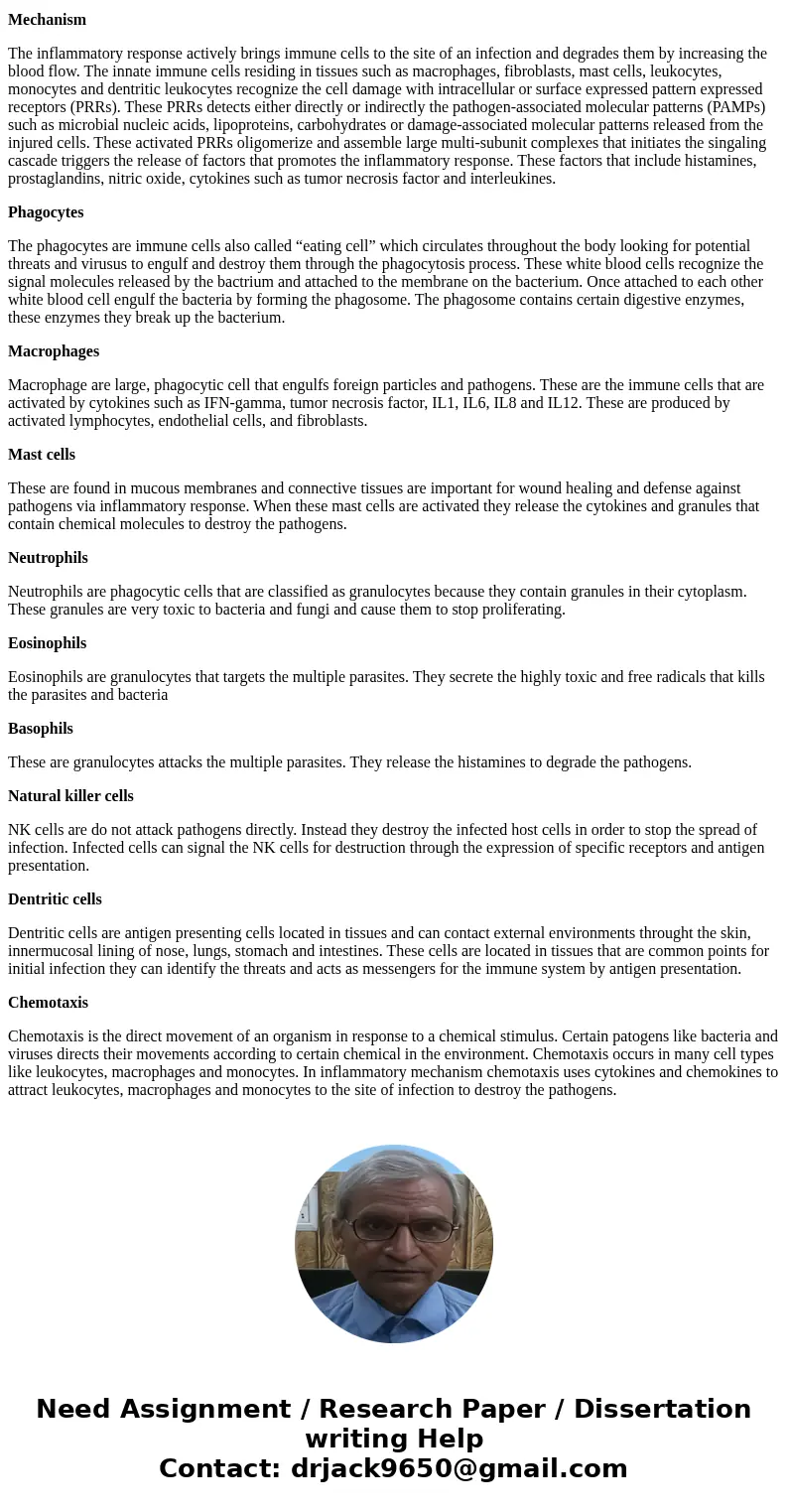Innate immune cells inflammatory response How do these innat
Innate immune cells (inflammatory response).
How do these innate cells they migrate? What signals (chemotaxis/cytokines) do they respond to?
Solution
Innate immune response
Innate immune cells are white blood cells they mediate the innate immunity that includes dentritic cells, basophils, eosionphils, Langerhans cells, mast cells, basophils, macrophages, neutrophils, and NK cells.
Then innate immune system is made of defense against infections that can be activated immediately once a pathogen attacks. The activated innate immune cells dramatically change their cell structure, migrate into new tissue sites, and produce large amounts of cytokines, chemokines and lipid mediators, such as prostaglandins and leukotrienes.
The essential function of innate immunity is to keep bacteria, viruses, parasites and foreign particles out of our body that causes diseases. The innate immune system includes physical barriers such as skin, GI tract, respiratory tract, cilia, nasopharynx, body hair and eyelashes and defense mechanisms that includes saliva, mucus secretion, tears, sweat, bile acid and gastric acid.
Mechanism
The inflammatory response actively brings immune cells to the site of an infection and degrades them by increasing the blood flow. The innate immune cells residing in tissues such as macrophages, fibroblasts, mast cells, leukocytes, monocytes and dentritic leukocytes recognize the cell damage with intracellular or surface expressed pattern expressed receptors (PRRs). These PRRs detects either directly or indirectly the pathogen-associated molecular patterns (PAMPs) such as microbial nucleic acids, lipoproteins, carbohydrates or damage-associated molecular patterns released from the injured cells. These activated PRRs oligomerize and assemble large multi-subunit complexes that initiates the singaling cascade triggers the release of factors that promotes the inflammatory response. These factors that include histamines, prostaglandins, nitric oxide, cytokines such as tumor necrosis factor and interleukines.
Phagocytes
The phagocytes are immune cells also called “eating cell” which circulates throughout the body looking for potential threats and virusus to engulf and destroy them through the phagocytosis process. These white blood cells recognize the signal molecules released by the bactrium and attached to the membrane on the bacterium. Once attached to each other white blood cell engulf the bacteria by forming the phagosome. The phagosome contains certain digestive enzymes, these enzymes they break up the bacterium.
Macrophages
Macrophage are large, phagocytic cell that engulfs foreign particles and pathogens. These are the immune cells that are activated by cytokines such as IFN-gamma, tumor necrosis factor, IL1, IL6, IL8 and IL12. These are produced by activated lymphocytes, endothelial cells, and fibroblasts.
Mast cells
These are found in mucous membranes and connective tissues are important for wound healing and defense against pathogens via inflammatory response. When these mast cells are activated they release the cytokines and granules that contain chemical molecules to destroy the pathogens.
Neutrophils
Neutrophils are phagocytic cells that are classified as granulocytes because they contain granules in their cytoplasm. These granules are very toxic to bacteria and fungi and cause them to stop proliferating.
Eosinophils
Eosinophils are granulocytes that targets the multiple parasites. They secrete the highly toxic and free radicals that kills the parasites and bacteria
Basophils
These are granulocytes attacks the multiple parasites. They release the histamines to degrade the pathogens.
Natural killer cells
NK cells are do not attack pathogens directly. Instead they destroy the infected host cells in order to stop the spread of infection. Infected cells can signal the NK cells for destruction through the expression of specific receptors and antigen presentation.
Dentritic cells
Dentritic cells are antigen presenting cells located in tissues and can contact external environments throught the skin, innermucosal lining of nose, lungs, stomach and intestines. These cells are located in tissues that are common points for initial infection they can identify the threats and acts as messengers for the immune system by antigen presentation.
Chemotaxis
Chemotaxis is the direct movement of an organism in response to a chemical stimulus. Certain patogens like bacteria and viruses directs their movements according to certain chemical in the environment. Chemotaxis occurs in many cell types like leukocytes, macrophages and monocytes. In inflammatory mechanism chemotaxis uses cytokines and chemokines to attract leukocytes, macrophages and monocytes to the site of infection to destroy the pathogens.


 Homework Sourse
Homework Sourse